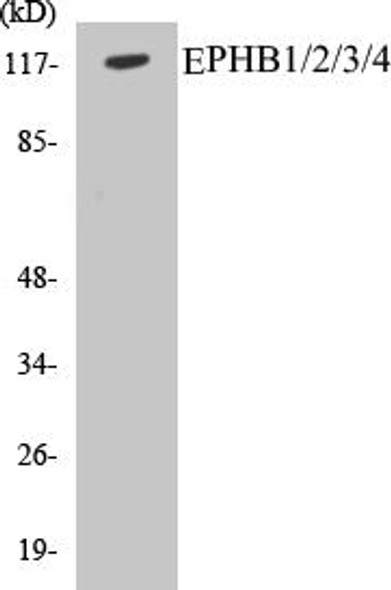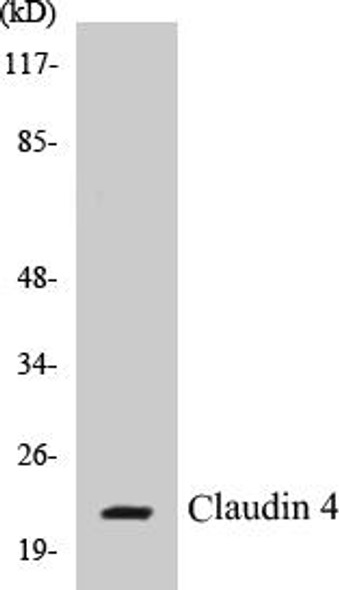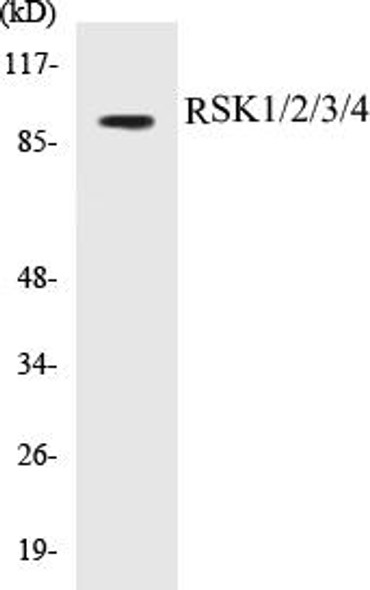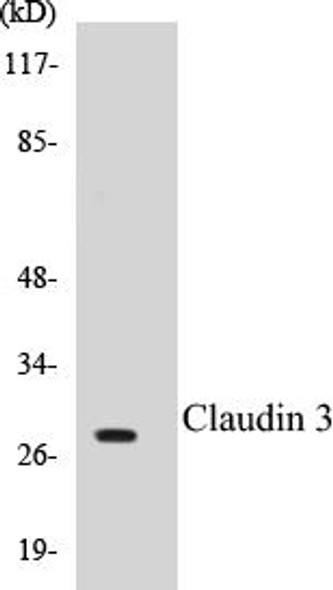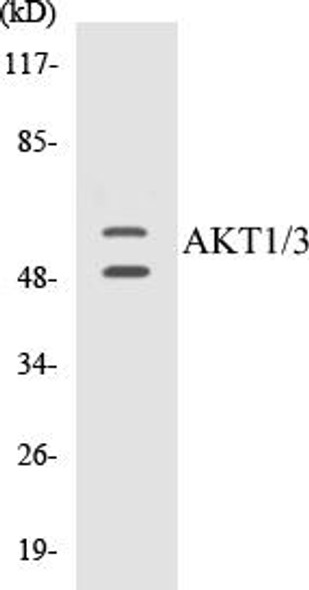EPHA2/3/4 Colorimetric Cell-Based ELISA Kit
- SKU:
- CBCAB00638
- Product Type:
- ELISA Kit
- ELISA Type:
- Cell Based
- Research Area:
- Cardiovascular
- Reactivity:
- Human
- Rat
- Detection Method:
- Colorimetric
Description
EPHA2/3/4 Colorimetric Cell-Based ELISA Kit
The EPHA2/3/4 Colorimetric Cell-Based ELISA Kit is specifically designed for the accurate quantification of EPHA2, EPHA3, and EPHA4 levels in cell lysates. This kit offers high sensitivity and specificity, allowing for reliable and reproducible results that are crucial for research in cell signaling pathways.EPHA2, EPHA3, and EPHA4 are important receptor tyrosine kinases that play key roles in various cellular processes, including cell adhesion, migration, and axon guidance. Dysregulation of these receptors has been implicated in diseases such as cancer, neurological disorders, and inflammatory conditions, highlighting their significance as potential therapeutic targets.
With the EPHA2/3/4 Colorimetric Cell-Based ELISA Kit, researchers can accurately measure EPHA2, EPHA3, and EPHA4 levels in cell lysates, enabling detailed investigation into their roles in cellular physiology and disease pathogenesis. This kit is an essential tool for advancing our understanding of EPHA receptor biology and developing novel therapeutic strategies targeting these receptors.
| Product Name: | EPHA2/3/4 Colorimetric Cell-Based ELISA |
| Product Code: | CBCAB00638 |
| ELISA Type: | Cell-Based |
| Target: | EPHA2/3/4 |
| Reactivity: | Human, Rat |
| Dynamic Range: | > 5000 Cells |
| Detection Method: | Colorimetric 450 nmStorage/Stability:4°C/6 Months |
| Format: | 96-Well Microplate |
The EPHA2/3/4 Colorimetric Cell-Based ELISA Kit is a convenient, lysate-free, high throughput and sensitive assay kit that can detect EPHA2/3/4 protein expression profile in cells. The kit can be used for measuring the relative amounts of EPHA2/3/4 in cultured cells as well as screening for the effects that various treatments, inhibitors (ie siRNA or chemicals), or activators have on EPHA2/3/4.
Qualitative determination of EPHA2/3/4 concentration is achieved by an indirect ELISA format. In essence, EPHA2/3/4 is captured by EPHA2/3/4-specific primary antibodies while the HRP-conjugated secondary antibodies bind the Fc region of the primary antibody. Through this binding, the HRP enzyme conjugated to the secondary antibody can catalyze a colorimetric reaction upon substrate addition. Due to the qualitative nature of the Cell-Based ELISA, multiple normalization methods are needed:
| 1. | A monoclonal antibody specific for human GAPDH is included to serve as an internal positive control in normalizing the target absorbance values. |
| 2. | Following the colorimetric measurement of HRP activity via substrate addition, the Crystal Violet whole-cell staining method may be used to determine cell density. After staining, the results can be analysed by normalizing the absorbance values to cell amounts, by which the plating difference can be adjusted. |
| Database Information: | Gene ID: 1969/2042/2043, UniProt ID: P29317/P29320/P54764, OMIM: 176946/179611/602188, Unigene: Hs.171596/Hs.123642/Hs.371218 |
| Gene Symbol: | EPHA2/3/4 |
| Sub Type: | None |
| UniProt Protein Function: | EphA2: a receptor tyrosine kinase. Receptor for members of the ephrin-A family. Binds to ephrin-A1, -A3, -A4 AND -A5. The Eph receptor tyrosine kinase family, the largest in the tyrosine kinase group, has fourteen members. They bind membrane-anchored ligands, ephrins, at sites of cell-cell contact, regulating the repulsion and adhesion of cells that underlie the establishment, maintenance, and remodeling of patterns of cellular organization. Eph signals are particularly important in regulating cell adhesion and cell migration during development, axon guidance, homeostasis and disease. EphA receptors bind to GPI-anchored ephrin-A ligands, while EphB receptors bind to ephrin-B proteins that have a transmembrane and cytoplasmic domain. Interactions between EphB receptor kinases and ephrin-B proteins transduce signals bidirectionally, signaling to both interacting cell types. Eph receptors and ephrins also regulate the adhesion of endothelial cells and are required for the remodeling of blood vessels. Overexpressed in many cancers including aggressive ovarian, cervical and breast carcinomas, and lung cancer. Expression correlates with degree of angiogenesis, metastasis and xenograft tumor growth. Soluble receptor inhibits tumor growth and angiogenesis in mice. |
| UniProt Protein Details: | Protein type:Protein kinase, TK; Membrane protein, integral; Protein kinase, tyrosine (receptor); Kinase, protein; EC 2.7.10.1; TK group; Eph family Chromosomal Location of Human Ortholog: 1p36 Cellular Component: cell surface; focal adhesion; integral to plasma membrane; intracellular; plasma membrane Molecular Function:ATP binding; ephrin receptor activity; protein binding; transmembrane receptor protein tyrosine kinase activity Biological Process: angiogenesis; axial mesoderm formation; axon guidance; bone remodeling; cell adhesion; cell migration; DNA damage response, signal transduction resulting in induction of apoptosis; ephrin receptor signaling pathway; keratinocyte differentiation; mammary gland epithelial cell proliferation; multicellular organismal development; negative regulation of protein kinase B signaling cascade; neural tube development; notochord cell development; notochord formation; osteoblast differentiation; osteoclast differentiation; peptidyl-tyrosine phosphorylation; protein kinase B signaling cascade; regulation of angiogenesis; regulation of blood vessel endothelial cell migration; regulation of cell adhesion mediated by integrin; skeletal development; vasculogenesis; viral reproduction Disease: Cataract 6, Multiple Types |
| NCBI Summary: | This gene belongs to the ephrin receptor subfamily of the protein-tyrosine kinase family. EPH and EPH-related receptors have been implicated in mediating developmental events, particularly in the nervous system. Receptors in the EPH subfamily typically have a single kinase domain and an extracellular region containing a Cys-rich domain and 2 fibronectin type III repeats. The ephrin receptors are divided into 2 groups based on the similarity of their extracellular domain sequences and their affinities for binding ephrin-A and ephrin-B ligands. This gene encodes a protein that binds ephrin-A ligands. Mutations in this gene are the cause of certain genetically-related cataract disorders.[provided by RefSeq, May 2010] |
| UniProt Code: | P29317 |
| NCBI GenInfo Identifier: | 229462861 |
| NCBI Gene ID: | 1969 |
| NCBI Accession: | P29317.2 |
| UniProt Secondary Accession: | P29317,Q8N3Z2, B5A968, |
| UniProt Related Accession: | P29317 |
| Molecular Weight: | |
| NCBI Full Name: | Ephrin type-A receptor 2 |
| NCBI Synonym Full Names: | EPH receptor A2 |
| NCBI Official Symbol: | EPHA2 |
| NCBI Official Synonym Symbols: | ECK; CTPA; ARCC2; CTPP1; CTRCT6 |
| NCBI Protein Information: | ephrin type-A receptor 2 |
| UniProt Protein Name: | Ephrin type-A receptor 2 |
| UniProt Synonym Protein Names: | Epithelial cell kinase; Tyrosine-protein kinase receptor ECK |
| Protein Family: | Ephrin type-A receptor |
| UniProt Gene Name: | EPHA2 |
| UniProt Entry Name: | EPHA2_HUMAN |
| Component | Quantity |
| 96-Well Cell Culture Clear-Bottom Microplate | 2 plates |
| 10X TBS | 24 mL |
| Quenching Buffer | 24 mL |
| Blocking Buffer | 50 mL |
| 15X Wash Buffer | 50 mL |
| Primary Antibody Diluent | 12 mL |
| 100x Anti-Phospho Target Antibody | 60 µL |
| 100x Anti-Target Antibody | 60 µL |
| Anti-GAPDH Antibody | 60 µL |
| HRP-Conjugated Anti-Rabbit IgG Antibody | 12 mL |
| HRP-Conjugated Anti-Mouse IgG Antibody | 12 mL |
| SDS Solution | 12 mL |
| Stop Solution | 24 mL |
| Ready-to-Use Substrate | 12 mL |
| Crystal Violet Solution | 12 mL |
| Adhesive Plate Seals | 2 seals |
The following materials and/or equipment are NOT provided in this kit but are necessary to successfully conduct the experiment:
- Microplate reader able to measure absorbance at 450 nm and/or 595 nm for Crystal Violet Cell Staining (Optional)
- Micropipettes with capability of measuring volumes ranging from 1 µL to 1 ml
- 37% formaldehyde (Sigma Cat# F-8775) or formaldehyde from other sources
- Squirt bottle, manifold dispenser, multichannel pipette reservoir or automated microplate washer
- Graph paper or computer software capable of generating or displaying logarithmic functions
- Absorbent papers or vacuum aspirator
- Test tubes or microfuge tubes capable of storing ≥1 ml
- Poly-L-Lysine (Sigma Cat# P4832 for suspension cells)
- Orbital shaker (optional)
- Deionized or sterile water
*Note: Protocols are specific to each batch/lot. For the correct instructions please follow the protocol included in your kit.
| Step | Procedure |
| 1. | Seed 200 µL of 20,000 adherent cells in culture medium in each well of a 96-well plate. The plates included in the kit are sterile and treated for cell culture. For suspension cells and loosely attached cells, coat the plates with 100 µL of 10 µg/ml Poly-L-Lysine (not included) to each well of a 96-well plate for 30 minutes at 37°C prior to adding cells. |
| 2. | Incubate the cells for overnight at 37°C, 5% CO2. |
| 3. | Treat the cells as desired. |
| 4. | Remove the cell culture medium and rinse with 200 µL of 1x TBS, twice. |
| 5. | Fix the cells by incubating with 100 µL of Fixing Solution for 20 minutes at room temperature. The 4% formaldehyde is used for adherent cells and 8% formaldehyde is used for suspension cells and loosely attached cells. |
| 6. | Remove the Fixing Solution and wash the plate 3 times with 200 µL 1x Wash Buffer for five minutes each time with gentle shaking on the orbital shaker. The plate can be stored at 4°C for a week. |
| 7. | Add 100 µL of Quenching Buffer and incubate for 20 minutes at room temperature. |
| 8. | Wash the plate 3 times with 1x Wash Buffer for 5 minutes each time. |
| 9. | Add 200 µL of Blocking Buffer and incubate for 1 hour at room temperature. |
| 10. | Wash 3 times with 200 µL of 1x Wash Buffer for 5 minutes each time. |
| 11. | Add 50 µL of 1x primary antibodies (Anti-EPHA2/3/4 Antibody and/or Anti-GAPDH Antibody) to the corresponding wells, cover with Parafilm and incubate for 16 hours (overnight) at 4°C. If the target expression is known to be high, incubate for 2 hours at room temperature. |
| 12. | Wash 3 times with 200 µL of 1x Wash Buffer for 5 minutes each time. |
| 13. | Add 50 µL of 1x secondary antibodies (HRP-Conjugated AntiRabbit IgG Antibody or HRP-Conjugated Anti-Mouse IgG Antibody) to corresponding wells and incubate for 1.5 hours at room temperature. |
| 14. | Wash 3 times with 200 µL of 1x Wash Buffer for 5 minutes each time. |
| 15. | Add 50 µL of Ready-to-Use Substrate to each well and incubate for 30 minutes at room temperature in the dark. |
| 16. | Add 50 µL of Stop Solution to each well and read OD at 450 nm immediately using the microplate reader. |
(Additional Crystal Violet staining may be performed if desired – details of this may be found in the kit technical manual.)


